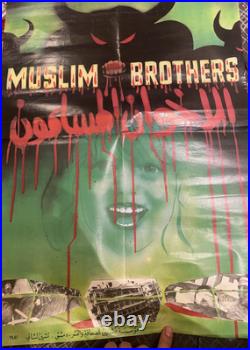Liban Lebanon Affiche Baath Assad Propaganda Anti Muslim-Brotherhood 1981 RARE

1976 marked the Syrian army's intervention in the Lebanese Civil War, initially against the Palestinian guerrillas (PLO). This was received with surprise across the Arab world and contributed to pre-existing reasons for discontent with the Syrian government. Historian Patrick Seale described this attack as "slaughtering Arabism's sacred cow".
In the same year, Syria experienced sporadic terror attacks, mostly explosions and assassinations. [32] The killings were largely aimed at prominent military officers, bureaucrats and government officials, including doctors and teachers.
Most of the victims were Alawites, which led some to suggest "that the assassins had targeted the community" but "no one could be sure who was behind" the killings. 16 June 1979 marked the day of the Aleppo artillery school massacre. Member of school staff, Captain Ibrahim Yusuf, called cadets to an urgent meeting at the dining hall. Once assembled, gunmen fired indiscriminately at the cadets with automatic weapons and grenades. [32] The massacre was masterminded by'Adnan'Uqla, a Fighting Vanguard commander.
[36][37]'Uqla committed the mass murder without the permission of the Fighting Vanguard's formal leader, Hisham Jumbaz, or its field commando in Aleppo. This massacre signalled a turn in the insurgency as it was now more than just a series of sporadic attacks, but a campaign of "large-scale urban warfare". [40] By August, the Brotherhood had declared a jihad against the Syrian government, effectively claiming responsibility for the insurgency.In the days leading up to 8 March 1980 (the 17th anniversary of the 1963 Ba'athist coup), nearly all Syrian cities were paralysed by strikes and protests, which sometimes developed into pitched battles with security forces. [42] The events escalated into a widescale crackdown in Aleppo, where the government responded with overwhelming military force, sending in tens of thousands of troops, supported by tanks and helicopters.
In and around Aleppo, hundreds of demonstrators were killed, and eight thousand were arrested. By April, the uprising in the area had been crushed. Between 1979 and 1981, Brotherhood insurgents continued to target Ba'ath party officials, party offices, police stations, military vehicles, barracks, factories, and even Russian officials. [40] Insurgents would form'hit teams' to kill Ba'ath party members in their sleep, such as'Abd al'Aziz al'Adi, who was murdered in front of his wife and children and had his body thrown into the street.
[44] On occasion, individuals who had denounced the killings were also targeted, including Sheikh al-Shami, Imam of the Suleymania mosque of Aleppo. Other instances of terrorism include attacks in August, September and November 1981, where the Brotherhood carried out three car-bomb attacks against government and military targets in Damascus, killing hundreds of people, according to the official press. [46] Among the victims were Soviet officials, experts, and their families serving with the United Nations. On 27 June 1980, Hafez Al Assad himself narrowly escaped death after a failed assassination attempt.The assailant fired a burst of rounds and threw two grenades, the first being kicked away by Assad and the second being covered by his personal bodyguard, Khalid al-Husayn, who died instantly. In retaliation, the very next day, Rifaat Al Assad's defence company flew into the infamous Palmyra prison in helicopters and killed hundreds of prisoners who had been Brotherhood-affiliates..